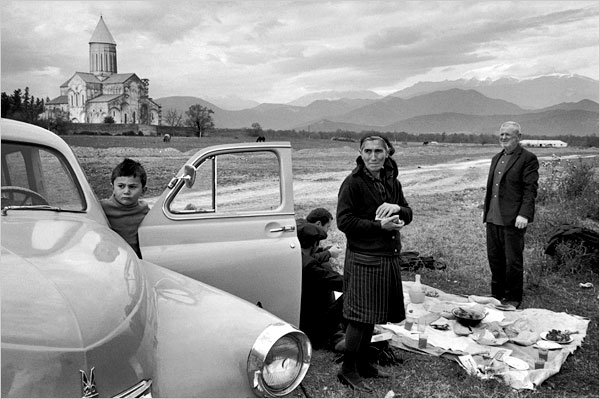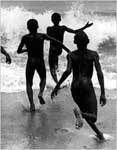Tag: Henri Cartier-Bresson
-
Worth a look: The Shooting Gallery – videos about photographers
The Shooting Gallery, a tumblr featuring videos about photographers. The videos are divided into two categories: photographers talking and photographers shooting. There are 14 pages of archives to the blog, in which you’ll find videos about the likes of Richard Prince, Donald Weber, Henri Cartier-Bresson, Jeff Mermelstein, Stephen Shore, Terry Richardson, Juergen Teller, Cindy Sherman,…
-
A father of modern photography: The hunter and his prey | The Economist
The hunter and his prey Henri Cartier-Bresson’s photographs are on show in New York until June 28th via The Economist: http://www.economist.com/culture/displaystory.cfm?story_id=15905863&fsrc=rss ALL IT takes to be a photographer, Henri Cartier-Bresson once said, is “one finger, one eye and two legs”. He visualised photography as a way of engaging with the world. He quietly stalked his…
-
Henri Cartier-Bresson at MOMA, review : The New Yorker
Henri Cartier-Bresson (1908-2004) was a taker of great photographs. Some three hundred of them make for an almost unendurably majestic retrospective at the Museum of Modern Art, from his famous portly puddle-jumper of 1932 (“Behind the Gare Saint-Lazare, Paris”) to views of Native Americans in Gallup, New Mexico, in 1971, one of his last visual…
-

‘Henri Cartier-Bresson,’ a Retrospective at MoMA – NYTimes.com
A Photographer Whose Beat Was the World The photographer Henri Cartier-Bresson is the subject of a handsome and large — though surely not anywhere near large enough — retrospective at the Museum of Modern Art. Link: http://www.nytimes.com/2010/04/09/arts/design/09cartier.html Rarely has the phrase “man of the world” been more aptly applied than to the protean photographer Henri…
-
The Online Photographer: H.C.-B.: The Invisible Man
H.C.-B.: The Invisible Man By Jim Hughes More than any other practitioner, I think, Henri Cartier-Bresson has defined the art of small-camera photography. Defying categorization (that bane of any true original), H.C.-B., neither photojournalist nor documentarian, seemingly traverse via The Online Photographer: http://theonlinephotographer.typepad.com/the_online_photographer/2010/01/hcb-the-invisible-man.html?utm_source=feedburner&utm_medium=feed&utm_campaign=Feed%3A+typepad%2FZSjz+%28The+Online+Photographer%29 “You must not photograph me!” he shrieked, his English suddenly crystal-clear. “No…
-
MoMA Announces a New Overview of Henri Cartier-Bresson's Panoramic Career
The Museum of Modern Art will present Henri Cartier-Bresson: The Modern Century, the first major retrospective in the U.S. in more than 30 years of one of photography’s most original and influential masters, from April 11 through June 28, 2010. Link: Artdaily.org – The First Art Newspaper on the Net
-
Photographers Henri Cartier-Bresson and Walker Evans: America exposed
Photographers Henri Cartier-Bresson and Walker Evans: America exposed |guardian.co.uk: In 2001, Henri Cartier-Bresson reflected on the long moment in the early 1940s when he had briefly considered turning from photography to film-making. “If it had not been for the challenge of the work of Walker Evans,” he wrote, “I don’t think I would have remained…
-
Words by Henri Cartier-Bresson (1973)
AMERICANSUBURB X: THEORY: “Words by Henri Cartier-Bresson (1973)”: I’ve been taking pictures when I was very young. I think I don’t remember what age. I started by painting and drawing and for me photography was a mean of drawing and that’s all. Immediate sketch done with intuition and you can’t correct it. If you have…
-
Henri Cartier – Bresson
“To take a photograph is to align the head, the eye and the heart. It’s a way of life.” Check it out here.
-

Innovator and Master, Side by Side
NYT: In 1932 the young Henri Cartier-Bresson, lately returned from Africa, saw a photograph of African children charging into waves on a beach. “I must say that it is that very photograph which was for me the spark that set fire to fireworks,” he recalled years later. “I couldn’t believe such a thing could be…
-
The Web This Morning
Photography – Olivier Rebbot, gallery link after Peter Howe introduction Photography – John Ficara’s Black Farmers in America Photography Dispatch – Iraqi Special Police Commandos by Guy Calaf Film Review – Henri Cartier-Bresson: The Impassioned Eye Photography – Idols + Believiers by Jocelyn Bain Hogg Artist – Christian-themed artist Thomas Kinkade is accused of ruthless…
-
The Web This Morning
Photos – The Seine, from source to sea, by Henri Cartier-Bresson, 1955 NYT Book Review – Ivan’s War NYT – US plans to give windfall to oil companies NYT editorial – White House shoots foot
-

The Web This Morning
From This Decisive Moment On New show of portraits by Henri Cartier-Bresson addresses issue of how his increasing fame impacted photographs he took of other famous people; show, at Cartier-Bresson Foundation in New York City, reflects power dynamic between photographer and subject; p Link: http://www.nytimes.com/2006/01/26/arts/design/26cart.html Jerome Liebling, a photographer, filmmaker and teacher, died Wednesday at…
